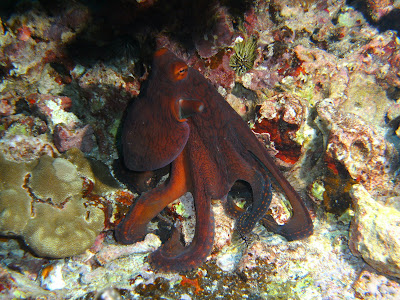Here on the Big Island today is just a day like any other day. Diving conditions were excellent although I noticed a couple things that seemed a little unusual. First, there was a lot of cold, fresh water percolating up through the water column. At one point my computer was indicating 73 deg. F. That's a little chilly! Also, I wouldn't exactly call it a current but there was a slight southward pull inside the bay today. Nothing major but perceptible, nevertheless.
Photo Copyright 2010 by Barry Fackler
I started my first dive as the sun was rising. A lot of fish were just coming out onto the reef after a night's rest. I saw this Day Octopus gliding along the reef top with a large Peacock Grouper escorting it. Like the goatfish in last week's post, the grouper follows the octopus, hoping to gobble up any little creatures the octopus may scare off the reef as it travels. This is the closest I've ever gotten to a grouper exhibiting this behavior. Usually they separate from the octopus until I move on.
Photo Copyright 2010 by Barry Fackler
Groupers can lunge at their prey very rapidly and engulf it by quickly opening their large mouths, creating a strong suction force. It would seem that the octopus is living dangerously here, however the interaction seems casual and non-threatening.
Photo Copyright 2010 by Barry Fackler
I got lots of good photos of the octopus as it let me follow it around the reef for some time. I saw two other octos on this dive.
Photo Copyright 2010 by Barry Fackler
This Green Linckia starfish has had a rough go of it! Two of its five arms are in the process of regenerating after some type of trauma. This is the type of sea star I see most often at Honaunau.
Photo Copyright 2010 by Barry Fackler
I photographed the Bullethead Parrotfish shown above just after it had finished what appeared to be a confrontation with another fish of the same species. They were aggressively swirling around each other and appeared to be snapping their jaws. Then this one swam in front of me with its fins flared while the other one swam away.
Photo Copyright 2010 by Barry Fackler
This Crocodile Needlefish is often mistaken for a Barracuda by snorkelers unfamiliar with the local marine life. There are similarities - both are good-sized silvery fish with intimidating teeth. These fish often jump clear of the water in their pursuit of small prey. Incredibly, there are documented cases of fatalities where fishermen were stabbed by the sharp beak of a leaping Needlefish.
Photo Copyright 2010 by Barry Fackler
As I returned to the Two-Step, I swam over this handsome Green Sea Turtle resting in a cozy sand patch. The shell on this one is almost completely clean. Often they can have a mossy coating of algae.
Photo Copyright 2010 by Barry Fackler
On my second dive, I headed north and happened upon this large school of Yellowfin Goatfish cascading down the face of the reef.
Photo Copyright 2010 by Barry Fackler
This Crown-of-Thorns sea star was stretched between the tops of two coral heads like a hammock between two palm trees. It would have been neat to see how this ended but it would have taken too long.
Photo Copyright 2010 by Barry Fackler
Threadfin Butterflyfish are not only nice-looking fish but they're also fairly curious about divers and, therefore, easy to photograph. As delicate as that dorsal thread appears, I've never seen a Threadfin that was missing it.
Photo Copyright 2010 by Barry Fackler
This trio of Blue Goatfish was prowling the reef in apparent search of a meal. These are young individuals which will get a bit beefier looking as they mature.
Photo Copyright 2010 by Barry Fackler
This little guy is an Ambon Toby that I found all tucked up under a ledge. Tobies like this are actually tiny pufferfishes measuring around 5" maximum. They are often seen in pairs but this one appeared to be all alone.
Photo Copyright 2010 by Barry Fackler
Slate Pencil Sea Urchins can be found on almost all Hawaiian reefs. They are fairly big but, during the daytime, they are quite capable of tucking themselves tightly into nooks and crannies on the reef. At night they come out and wander about the reef.
Thus ended my post-tsunami dive excursion. I don't work for the Chamber of Commerce but I do want people to know that the reefs are in good shape here and the tsunami was of no consequence. If you're planning a trip to Hawai'i, there's no reason to change your mind.





















































